Costa Tropical of Granada - Charming Villages, Top Attractions and Beaches
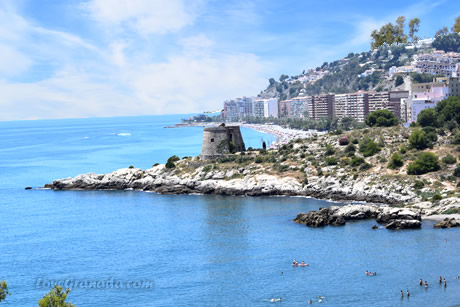
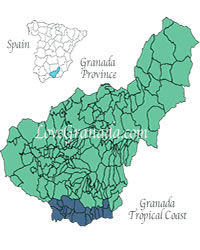
Enjoy a special day at the Alhambra with a guided tour
 Alhambra and Nasrid Palaces: discover the wonders of the Alhambra with this all-inclusive tour: the Nasrid Palaces, the Generalife, the Alcazaba, and more.
Alhambra and Nasrid Palaces: discover the wonders of the Alhambra with this all-inclusive tour: the Nasrid Palaces, the Generalife, the Alcazaba, and more.
 Alhambra + Albaicín + Sacromonte: a perfect combination of a guided tour of the Alhambra in the morning and a guided tour of the Albaicin and Sacromonte in the afternoon.
Alhambra + Albaicín + Sacromonte: a perfect combination of a guided tour of the Alhambra in the morning and a guided tour of the Albaicin and Sacromonte in the afternoon.Seventeen municipalities share the name Costa Tropical (or Granada Costa). Some of them are inland, nestled in a surprising enclave between mountains and tropical valleys, where delicious avocado and mango thrive, such as Jete, Molvízar or Ítrabo.
Motril, Almuñécar and Salobreña are three of the most prominent beach towns on the coast of Granada, each with a rich history dating back to the time of the Carthaginians and even further back to the Iberians.
Below, you can find detailed information about each of these villages, including what to see, how to reach, where to eat, and their beaches:
Almuñécar Guide
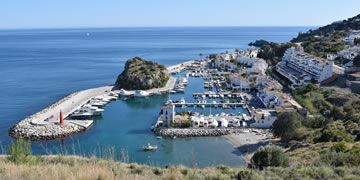 The beaches, castle, charming white streets, marina, and lively nightlife make Almuñécar a perfect destination to spend your holidays.
The beaches, castle, charming white streets, marina, and lively nightlife make Almuñécar a perfect destination to spend your holidays.
Salobreña Guide
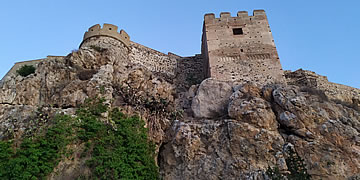 Perched on a rocky hill and crowned with a thirteenth-century Arab castle, it's arguably the most beautiful town on the Costa Tropical.
Perched on a rocky hill and crowned with a thirteenth-century Arab castle, it's arguably the most beautiful town on the Costa Tropical.
Motril Guide
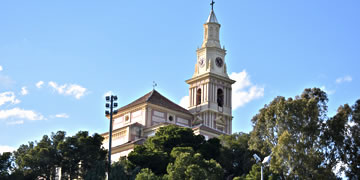 A modern town at the foot of Sierra de Lújar, surrounded by lush fields, known for its exotic landscape, churches, and tapas bars.
A modern town at the foot of Sierra de Lújar, surrounded by lush fields, known for its exotic landscape, churches, and tapas bars.
La Herradura Guide
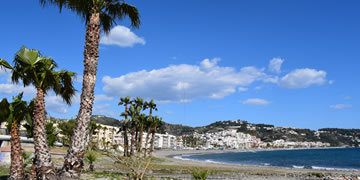 A horseshoe-shaped fishing village, with white, steep streets, boasting some of the best beaches, scuba diving, and natural spots.
A horseshoe-shaped fishing village, with white, steep streets, boasting some of the best beaches, scuba diving, and natural spots.
While the beaches along the Granada coast may not be as developed as those in Malaga, there are still plenty of charming spots and small coves waiting to be discovered.
What distinguishes the Costa Tropical from other regions?
- Beaches: the region is distinguished by its beaches,
which are almost entirely composed of black sand or pebbles with a thick texture.
More information about Costa Tropical beaches in: Almuñécar, Salobreña, Motril, La Herradura and 10 best beaches in Granada. - Climate: enjoys a subtropical microclimate because of its protected location by Sierra Nevada mountains. This results in mild winters and hot summers.
- Tourism: less developed for mass tourism compared to the Costa del Sol (Malaga),
for example, it offers more relaxed atmosphere with smaller towns and villages.
Find more information on what to see in Costa Tropica in: Almuñécar, Salobreña, Motril, La Herradura. - Geography: it is characterized by its subtropical climate and abundant vegetation, including tropical fruits such as avocados and mangoes.
- Attractions: has a mix of charming coastal villages, agricultural landscapes, and historical sites such as the
Almuñécar Castle and the Salobreña Castle.
For information on water activities, find more details in: Diving Courses and Baptism.
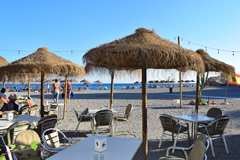
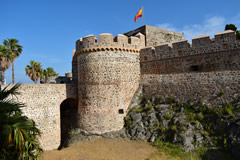
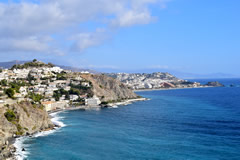
Throughout most of the year, you can admire the snowy peaks of Sierra Nevada from these beaches, creating a picturesque scene and offering travelers the unique opportunity to experience both the sea and the snow in a single day.
Location and boundaries of the Costa Tropical of Granada
The Costa Tropical is a coastline situated between the eastern part of the province of Málaga and the western part of the province of Almería.On this map you can see the boundaries of the Costa Tropical. Some municipalities are inland while others are situated next to the coast.
Make your experience in Granada even more complete and memorable
10 Best Caves and Venues for Flamenco in Granada: immerse yourself in the passion of flamenco and live unique experiences in the best tablaos in the city.
Authentic Arab Baths and Relaxing Massage: enjoy a deep relaxation experience with an exclusive massage in a traditional setting.
The villages located next to the seaside are: La Herradura, Almuñécar, Salobreña, Torrenueva, Carchuna, Calahonda, Catel del Ferro, Castillo de Baños, La Mamola, Los Yesos, Melicena y La Rábita.
Weather of the Costa Tropical
 The weather on the coast of Granada is considered subtropical, making it the only region in Europe
where crops such as the famous chirimoyas in Motril, along with avocados and mangos, thrive.
The weather on the coast of Granada is considered subtropical, making it the only region in Europe
where crops such as the famous chirimoyas in Motril, along with avocados and mangos, thrive.
Each year, Costa Tropical gets noticeably hotter, with summers growing warmer and the heat lasting longer. The rising temperatures are becoming a defining feature of the region’s climate.
The annual average temperature is 20ºC, with winter lows of 14ºC and summer highs reaching 33ºC. In extreme cases, temperatures can sometimes soar as high as 40°C.
Villages Along the Way from Granada to Costa Tropical
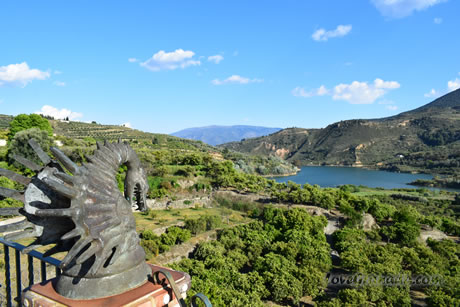 Some small roads along the route from Granada to the coast lead to several interesting villages.
Some small roads along the route from Granada to the coast lead to several interesting villages.
We definitely recommend visiting the Valle de Lecrin, which resembles an orchard of blooming orange trees, with many small white towns scattered across the landscape until you reach the Beznar Dam. The area offers numerous hiking trails and rural accommodations.
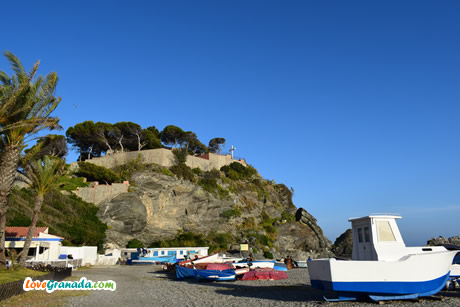 A local road branching off to the right of the national road, just after Vélez de Benaudalla, leads to Los Guájares,
comprising the three white villages of Guájar
Faragüit, Guájar Fondón, and Guájar Alto.
A local road branching off to the right of the national road, just after Vélez de Benaudalla, leads to Los Guájares,
comprising the three white villages of Guájar
Faragüit, Guájar Fondón, and Guájar Alto.
These villages are nestled in a mountainous area adorned with lush ravines and subtropical crops.
Vélez de Benaudalla is a place that preserves the ruins of an Arab castle and a sixteenth-century church.
Distinct Features of the Costa Tropical
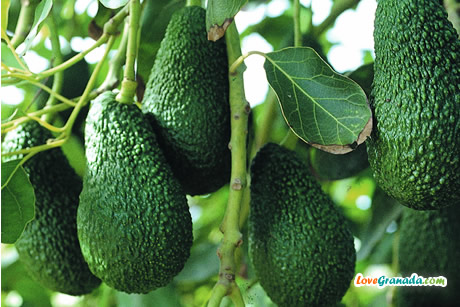 Due to the climatic conditions, it's not surprising that exotic tropical fruits,
unique in all of Europe, are grown here. For instance, the cherimoya,
which holds a denomination of origin, thrives in this region.
Due to the climatic conditions, it's not surprising that exotic tropical fruits,
unique in all of Europe, are grown here. For instance, the cherimoya,
which holds a denomination of origin, thrives in this region.
This South American fruit is exclusively grown in this area of Europe, with Spain being the world's leading producer. Additionally, there is an abundance of papayas, avocados, mangoes, guavas, and so on.
Another defining characteristic of the Costa Tropical is sugar cane. In these lands, where the alluvium of the Guadalfeo River is located, sugar cane has been cultivated for many centuries.
 Apparently, sugar cane entered Europe through the Iberian Peninsula, specifically from the Kingdom of Granada, the only place where
it took root and where it was cultivated until 2006.
Apparently, sugar cane entered Europe through the Iberian Peninsula, specifically from the Kingdom of Granada, the only place where
it took root and where it was cultivated until 2006.
Unfortunately, the sugar factories on the Costa Tropical closed, one after the other, and sugar is no longer produced in the area, although rum is still produced: Ron Montero.
A visit to its factory will unveil a part of the history of sugar cane cultivation in Granada.
Historical and Cultural Heritage
The charm of many of its corners makes this coast a very special place, both for its landscape full of contrasts and for its historical and cultural heritage.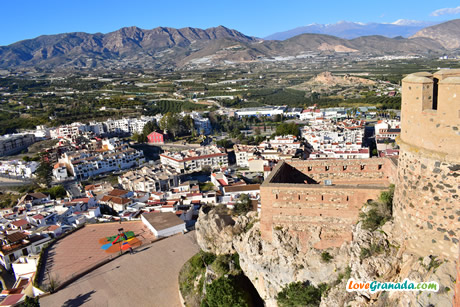 The Costa Tropical of Granada has such an ancient history that dates back to the times of the Carthaginians. There are remains
of Roman walls and aqueducts, Arab castles, and churches from the 16th century.
The Costa Tropical of Granada has such an ancient history that dates back to the times of the Carthaginians. There are remains
of Roman walls and aqueducts, Arab castles, and churches from the 16th century.
Don't miss the sunset at the Peñón del Santo, in San Cristóbal Beach, where you can contemplate the sea and a large part of Almuñécar.
Visit the Paseo de las Flores, in Salobreña, and enjoy its beautiful medieval streets in the vicinity of the Moorish Castle.
Although there are many other small towns of special interest, not only on the coast but also inland, such as Los Guájares, Molvízar and Vélez de Benaudalla, which are worth visiting for their lush vegetation and historical monuments.
What else does the Costa Tropical offer?
- Costa Tropical Beaches: along this exotic stretch of the Costa Tropical, there are 26 beaches, spanning a length of 19 km.
- Campings near the Beach: charming campsites nestled in quiet surroundings, right next to one of the top beaches on the Costa Tropical.
- Scuba Diving Centres: Costa Tropical offers numerous spots for diving, offering opportunities to explore captivating underwater ecosystems
Typical Cuisine of the Costa Tropical
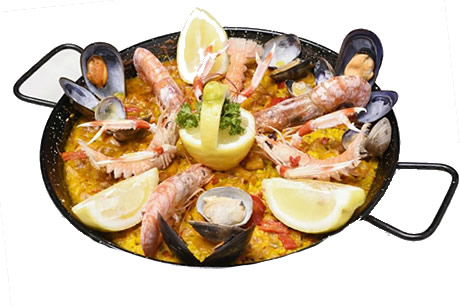 The cuisine of the Costa Tropical is based on ancient traditions influenced by the many civilizations
that have arrived on its shores, including the Phoenicians, Greeks, Romans, and Arabs.
The cuisine of the Costa Tropical is based on ancient traditions influenced by the many civilizations
that have arrived on its shores, including the Phoenicians, Greeks, Romans, and Arabs.
Granada's Tropical Coast is famous for its fish: marinated blue fish and squid.
Sardines are cooked in a very special way that requires a lot of technique. It’s called 'espeto', a traditional method of cooking sardines that resembles a barbecue made in a boat filled with ashes. You can find this delicacy in the 'chiringuitos' or beachside restaurants.
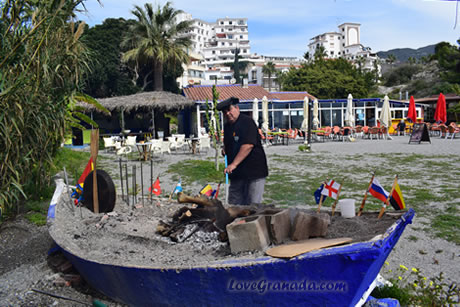 Enjoy dishes like paella, gazpacho, and salads, all washed down with Costa wine, produced in the surrounding
mountain villages. Don't miss the cane rum made in Motril, the only rum produced in Europe!
Enjoy dishes like paella, gazpacho, and salads, all washed down with Costa wine, produced in the surrounding
mountain villages. Don't miss the cane rum made in Motril, the only rum produced in Europe!
However, what stands out the most in the Costa Tropical are the fruits: chirimoyas, mangoes, avocados, etc.
Also, you should try Moorish-inspired desserts such as the Torta Real, made with almonds and sugar, as well as roscos fritos and pestiños from Vélez.
 We also want to mention the amazing homemade ice creams you can buy in the local
ice cream shops, or 'heladerías'.
We also want to mention the amazing homemade ice creams you can buy in the local
ice cream shops, or 'heladerías'.
You should try the famous "leche merengada" made at Perandres since 1900. They are located in Salobreña, Torrenueva and Motril.
Also, check out the Food of the Alpujarra and Food of Granada pages.
How to Reach Costa Tropical of Granada
How to Reach Costa Tropical by Car
 From Granada take the highway A-44, known as Autovía de Sierra Nevada,
heading towards Motril.
From Granada take the highway A-44, known as Autovía de Sierra Nevada,
heading towards Motril.
Then it connects to the A-7 highway, known as Autovía del Mediterráneo, where you can choose to travel west towards Malaga or east towards Almería.
Taxi to the Costa Tropical of Granada
Approximate taxi fares from Granada to Granada Costa Tropical villages: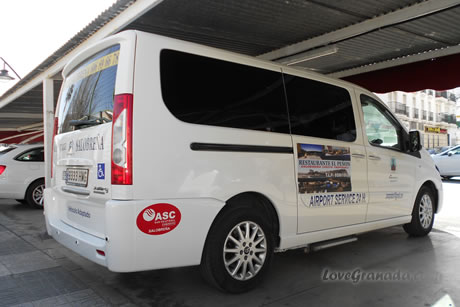 Granada - Salobreña: 80 (fare 1), 95 € (fare 2).
Granada - Salobreña: 80 (fare 1), 95 € (fare 2). Granada - Motril: 85 (fare 1), 100 € (fare 2).
Granada - Almunécar: 100 (fare 1), 120 € (fare 2).
Granada - La Herradura: 110 (fare 1), 120 € (fare 2).
Fare 1: Monday-Thursday from 7:00 to 22:00 h, Friday from 07:00 to 21:00 h.
Fare 2: Monday-Thursday from 22:00 to 07:00 h, Friday from 21:00 to 07:00 h. Saturdays, Sundays and Bank Holidays.
 For more information, including phone numbers and addresses:
Granada taxis.
For more information, including phone numbers and addresses:
Granada taxis.
Buses to the Costa Tropical of Granada
The buses between Granada and the Costa Tropical are operated by Alsa.It costs between 7 and 10 euros euros to travel to the villages of Salobreña, Motril, Alnu&ñéecar or Herradura.
More information in Granada buses.
Page Updated: Jun 07, 2025
Was this useful? Been to these sights? Share your thoughts!
© Copyright •
LoveGranada.com • Any use of the content, including copying of it in whole or in part is prohibited.
You Might Also Be Interested In
Opinions about Tropical Coast of Granada
It was worth traveling
I had heard very good things about this town and its people. For this reason, I decided to spend my vacation in Almuñécar. It was worth traveling almost 1000 kilometers. We are leaving very satisfied and happy to have visited this beautiful place.
Recommended villages
My favorite place on Granada’s tropical coast is Salobreña. It is crowded in summer but is an excellent place to visit in spring and autumn. You should see the city centre and its castle.
If you are looking for a quite beach, you should visit Castell del Ferro, it is a quiet little unknown village with very few tourists.
Best villages on the Costa Tropical
La Herradura (meaning horseshoe because of its shape) has one of the prettiest bays on the tropical coast of Granada. Salobreña has very nice historic centre, Arabic castle, narrow streets and white houses. Almuñecar is an emblematic place, worth a visit as well.

